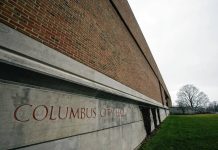Two decades after exterior renovations to the Bartholomew County Courthouse were last completed, another is likely to take place in 2017.
Significant erosion to the limestone foundation and brickwork below vents on the lower part of the clock tower must be addressed quickly, county maintenance director Rick Trimpe recently told the Bartholomew County commissioners.
While the work isn’t likely to disrupt the courts and other county offices in the 142-year-old building, cost to the cash-strapped county could soar in excess of $1 million, Trimpe said.
Alerted to the problem about a month ago, commissioner Larry Kleinhenz used a pair of binoculars to examine damage to the clock tower.
[sc:text-divider text-divider-title=”Story continues below gallery” ]
“There’s some serious erosion going on,” he said.
If damage to the historic building isn’t taken care of, the erosion will get progressively worse — and more expensive to correct, Trimpe said.
Without quick attention, moisture caught in cracks of the stone will begin seeping into the interior, dissolving mortar joints and popping the faces off the brick, he said.
“We need to get on this and get it fixed,” Trimpe said.
Calling the $1 million a ballpark figure, a more precise estimate cannot be determined until after experts are brought in to do a thorough assessment of the damage, he said.
Hamilton and other Indiana counties with buildings of similar age and deterioration are either constructing or considering new facilities, said Richard McCoy, executive director of Landmark Columbus, an organization under the Heritage Fund umbrella that was founded last year to care for the city’s artistic and architectural sites.
But the Bartholomew County Courthouse — dedicated in 1874 — is in a league of its own as one of downtown Columbus’ iconic structures.
“Every picture you see, it has that Courthouse peaking through from one angle or another,” McCoy said.
The courthouse and another distinctive building — the former Columbus City Hall, built in 1895 and now a mixed-use building at Fifth and Franklin streets that includes apartments — were the first local buildings to be placed on the National Register of Historic Places on Nov. 15, 1979, McCoy said.
Buildings such as the Courthouse are a window to the past, he said.
“It’s like a time capsule, in that it gives us a look back to the aspirations of the community in the 1870s,” McCoy said. “It defines how we understand ourselves, so I really hope it’s well maintained.”
Been there before
This is the second time over the past two decades that county commissioners have dealt with physical deterioration of the Courthouse building.
Erosion was addressed after similar damage was discovered over a much larger area of the building in the mid 1990s, Kleinhenz said.
While between $500,000 and $1 million was spent to fix half of the problem areas in 1997, “we’re seeing the other half we should have replaced then — but thought we could get by without,” the commissioner said.
Although the county was in better financial shape back then, county officials at the time were preparing to invest $300,000 on extensive first-floor interior renovations at the Courthouse, as well as $252,000 for a new heating and air conditioning system. Both projects were completed the following year.
Most of the labor in 1997 was performed by county employees, and Trimpe believes his staff is also capable of handling the new work, he told the commissioners.
The project will involve first chipping or grinding out deteriorating sections, sliding in a veneer piece, and using mortar to secure the new stone in place, Trimpe said.
That’s not the only damage that needs to be addressed on the Courthouse property, however, Kleinhenz said.
Erosion also is evident on 21 small limestone base pieces at the Bartholomew County Memorial for Veterans, completed in 1997.
The county received a $48,000 quote to replace those base pieces.
Meanwhile, county government leaders also will be trying to address serious deterioration at the 64-year-old Bartholomew County Highway Garage facility near State Street and Gladstone Avenue.
Paying for renovations
The need to repair significant county-owned properties could increase already mounting pressure on the three county commissioners to levy a new cumulative capital development tax that is already assessed by a vast majority of Indiana counties, Bartholomew County Auditor Barb Hackman said.
If enacted, it would increase taxes on all residential and business real estate by .0166 cents per $100 of assessed valuation the first year, raising between $600,000 and $700,000, according to Hackman’s current estimates.
For a property owner with a home assessed at $100,000 who takes normal deductions, the first year impact would be $5.44, Hackman said. For owners of a $200,000 assessed residence, the tax liability would be $16.26 annually, she said.
That would be followed by up to .033 cents annually — double the amount — in subsequent years, creating between $1.2 million and $1.3 million in additional revenue, the auditor said.
But even if the commissioners approved the new tax this year, collections would not take effect until 2017 — and monies will not be received by county government until 2018, Hackman said.
[sc:pullout-title pullout-title=”Courthouse history ” ][sc:pullout-text-begin]
Dedication of the Bartholomew County Courthouse took place on Dec. 29, 1874.
Irish-born architect Issac Hodgson (1826-1909) designed the second Empire-style structure to be the first fireproof building in the state. Other courthouses designed by the Indianapolis-based architect are still standing in Jennings, Morgan and Henry counties.
Much of the original décor, from the marble and terrazzo floors to the wood, plaster and cast iron trim, have been preserved. The building originally was roofed in slate, but was recovered with copper in 1953.
The delicate, lightweight alloy grillwork on the three towers, which replaced the original grillwork, was added in 1971, a gift of the late Elsie Irwin Sweeney.
[sc:pullout-text-end]




